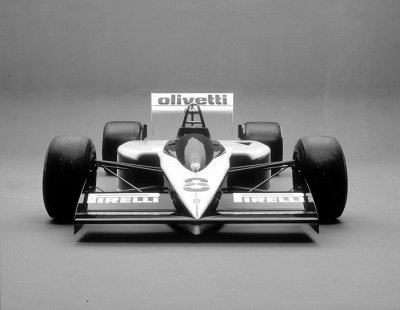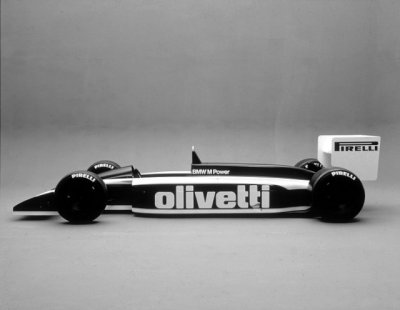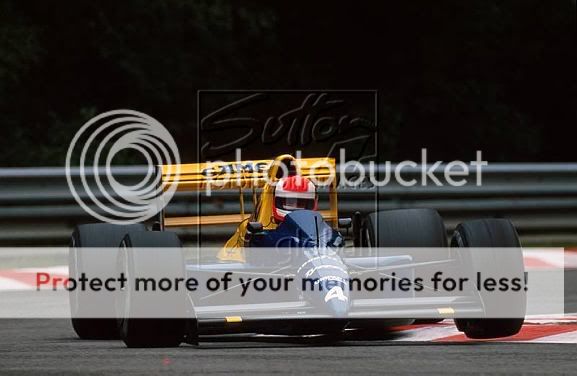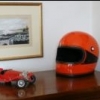
What should an F1 car look like?
#1

Posted 28 November 2011 - 21:57
Quite liked the 16, Maybe the FW14, 15 and 16
What do you guys think?
Advertisement
#2

Posted 28 November 2011 - 22:35

or this.....

or this.....

Copyright JAG
#3

Posted 28 November 2011 - 23:58
It should look like this......
or this.....
or this.....
Copyright JAG
1967: THE year for producing great looking, great sounding, technically diverse GRAND Prix cars without the visual distraction of wings or sponsorship.Just a purity of line and purpose that has never been surpassed.
#4

Posted 29 November 2011 - 00:01
#5

Posted 29 November 2011 - 03:21
While I would not disagree with many of the suggestions above or those to follow going all the way back to the dawn of racing, I have very little concern for what formula one cars look like so long as at the end of each and every race they were running, without the use of all the frankly ridiculous gizmo's that are required today, like this for the top four positions !

gif image hosting
#6

Posted 29 November 2011 - 03:46
It should look like this......
or this.....
or this.....
Copyright JAG
Indeed, I loved all three of them, but especially the Ferrari with that exhaust system and the solid/non-perspex cockpit surround
#7

Posted 29 November 2011 - 05:00

#8

Posted 29 November 2011 - 07:16

Power to fantasy.
#9

Posted 29 November 2011 - 09:48
Power to fantasy.
I'm sorry but it most certainly should not look like that!
I think the earlier posts of Ferrari, Lotus and Eagle racers from 1967/68 are to my mind the epitome of what a Grand Prix F1 car should look like!
#10

Posted 29 November 2011 - 10:09
#11

Posted 29 November 2011 - 10:28
so I think it should look like a 2006 GP2 car but with a smaller front wing (with a tight box rule to keep the size down) and a full-length plank from the front of the front tyre to the back of the back tyre, and no rear diffuser.
And the rules should be written by a designer with a particularly furtive mind.....
Paul M
#13

Posted 29 November 2011 - 11:59
#14

Posted 29 November 2011 - 12:34
Realistically we can't undiscover aerodynamics.....
so I think it should look like a 2006 GP2 car but with a smaller front wing (with a tight box rule to keep the size down) and a full-length plank from the front of the front tyre to the back of the back tyre, and no rear diffuser.
And the rules should be written by a designer with a particularly furtive mind.....
Paul M
I agree, we can't undiscover aerodynamics but we can limit the designers ability to exploit them by keeping the wing sizes and areas of the car that are used to an absolute minimum.
What about everything else though? I've always thought the over prescriptive rules that apply to engine design, i.e. number of cylinders etc, will inhibit creativity and push up costs. Why not allow complete freedom of engine design and configuration, limit aerodynamics, increase minimum weight by 150Kgs so that breaking distances are a reality again and retrurn to steel discs?
Could be interesting.
#15

Posted 29 November 2011 - 12:52
Gradually from 1989 onwards, all the teams moved towards V10's because they were the best combo of fuel efficiency and power. Although Toyota were looking at a V12 engine before they entered F1 (did it get past the concept stage?), then the FIA banned engines of more than 10 cylinders anyway...
Edited by nmansellfan, 29 November 2011 - 12:52.
#16

Posted 29 November 2011 - 14:20
Realistically we can't undiscover aerodynamics.....
True but then again as other posters have suggested you can ban rear wings and limit the width of the cars overall.
Over prescriptive rules to engine design often push up costs because teams naturally start chasing the small things like the efficiency of engine oils etc, when the more open routes to gaining power are closed off by regulations. But then when engine regs are more open, teams spend huge money chasing power anyway, just with more freedom! The other point is that in aerodynamic design and engine design (specifically to GP racing), we've got to a point where there has been so much development and evolutiuon over the years, the most ideal solution has usually already been reached - example being the V10 engine from 1996 until the 2.4 litre V8's were mandated.
Gradually from 1989 onwards, all the teams moved towards V10's because they were the best combo of fuel efficiency and power. Although Toyota were looking at a V12 engine before they entered F1 (did it get past the concept stage?), then the FIA banned engines of more than 10 cylinders anyway...
I do think the 'one size fits all' concept of a 2.4 litre V8 is complete and utter rubbish. Back in 1968 we had BRM V12, Ferrari V12, Maserati V12, Weslake V12, Honda V12 and Matra V12 all battling with the Cosworth DFV V8 and the Repco V8. Each engine had a distinctive sound and when I went to Monaco and sat in the Casino Square the NOISE was fantastic. Now-a-days the engines all sound roughly the same - with the emphasis on rough!
#17

Posted 29 November 2011 - 14:41
Power to fantasy.
"If Major Mallock had been into Indycar design...."
Actually I rather like it! Such variety is much missed in todays single seaters!
#18

Posted 29 November 2011 - 15:35
Bring back bolster tanks and exposed spare wheels.
#19

Posted 29 November 2011 - 16:45
Aerodynamics have ruined Grand Prix racing.
Bring back bolster tanks and exposed spare wheels.
And the 'greasemonkey'!
Advertisement
#20

Posted 29 November 2011 - 19:08
It should have narrow section wheels and treaded tyres, and not aquaplane if someone spits on the track, It should be painted red, green, blue, yellow or silver, and have the engine in front of the driver .....................Oh!
I think I must be regressing.......................................
#21

Posted 29 November 2011 - 19:54
So this would qualify:For a start it should not look like a billboard or advertising hoarding, also it should allow the drivers upper body to be in full view with room for the elbows to swirl about.
It should have narrow section wheels and treaded tyres, and not aquaplane if someone spits on the track, It should be painted red, green, blue, yellow or silver, and have the engine in front of the driver .....................Oh!
I think I must be regressing.......................................

Unfortunately, by the time the Scarab was ready to race, successful Formula 1 cars no longer looked like that. However, like the next American F1 car, Dan Gurney's Eagle, it looked beautiful.
#22

Posted 29 November 2011 - 21:47
So: no wings, no adverts, treads on the tyres; don't mind which end the engine sits.
#23

Posted 30 November 2011 - 00:22
That said, is it possible we most revere the cars that drew us in during our first exposures to the sport? If we asked this question of someone first witnessing a 2011 race, would they answer "2011" in 20 years from now? Just curious...
#24

Posted 30 November 2011 - 01:15
#25

Posted 30 November 2011 - 01:50

(previously posted elsewhere)
#26

Posted 30 November 2011 - 01:50


#27

Posted 30 November 2011 - 02:26

Photo by Sutton Images
#28

Posted 30 November 2011 - 05:07

Uploaded with ImageShack.usCopyright Unknown.
Edited by eldougo, 01 December 2011 - 04:57.
#29

Posted 30 November 2011 - 05:59
There seems to be a lot of evidence to support that view Eric. Mind you, the FI and sports cars of c1957 that I was first exposed to really WERE the best looking!Funny you guys mention 1967, as I was always drawn to that era of Can-Am cars as well. But those were my earliest memories of real race cars.
That said, is it possible we most revere the cars that drew us in during our first exposures to the sport? If we asked this question of someone first witnessing a 2011 race, would they answer "2011" in 20 years from now? Just curious...
[I've conveniently almost forgotten the immediate post war home made jobs that I saw as a toddler.]
#30

Posted 30 November 2011 - 08:05
#31

Posted 30 November 2011 - 13:02
Over prescriptive rules to engine design often push up costs because teams naturally start chasing the small things like the efficiency of engine oils etc, when the more open routes to gaining power are closed off by regulations. But then when engine regs are more open, teams spend huge money chasing power anyway, just with more freedom! The other point is that in aerodynamic design and engine design (specifically to GP racing), we've got to a point where there has been so much development and evolutiuon over the years, the most ideal solution has usually already been reached - example being the V10 engine from 1996 until the 2.4 litre V8's were mandated.
Gradually from 1989 onwards, all the teams moved towards V10's because they were the best combo of fuel efficiency and power. Although Toyota were looking at a V12 engine before they entered F1 (did it get past the concept stage?), then the FIA banned engines of more than 10 cylinders anyway...
I think they got the best combination of fuel efficiency and power from what they had to work with within the rather prescriptive rule book. I'm sure that if you asked them what they would preferred to be working on there would have been a variety of answers. The FIA likes to justify their stance by claiming it keeps costs down but I'm not convinced that the engine manufacturers throwing vast amounts of money at trying to gain an advantage over someone else with essentially the same kit is a good way of cutting the budgets.
The rigid rule book makes it one step closer to becoming, in the public's eyes, a glorified one make formula.
But, back to the main point of the discussion:
Maserati 250F
Vanwall
Eagle
1966 Ferrari
And, because they were so ugly they became attractive (!
Ligier JS5
H16 BRM
1970 Matra F1
Some of the early 70s F5000 cars looked the part too.
#32

Posted 30 November 2011 - 14:52
Engines: everything goes as long they can get over the distance with lets say 75 litres of fuel.
Electronics: get rid of everything that is adjustable during drive! No buttons or gauges in the steering 'wheel'!
Stick shift and steel brakes would be great too. On-board starter.
We can't undevelop aerodynamics but it should be possible to restrict them to a level that won't eat tons of money and ages in windtunnels during the season.
Flat bottom from the tip of the nosecone to the center of the rear wheels and no more body work behind that line.
The tip of the nosecone IS the tip of the cars bottom!
Wings can have only two aerodynamicaly profiled elements.
All wing elements have to have straight front and rear edges.
End plates have to be flat and vertical without any kind of openings or non-vertical extensions.
Front wing has to be mounted at the sides of the nosecone. Rear wing has to be center mounted at the gearbox.
No bullshit fins or plates anywhere between front and rear wheels.
The exhaust has to end behind the rear wheels.
Front wings are not mandatory.
Also: every car has to have a NUMBER BIG ENOUGH SO EVERYBODY CAN INSTANTLY READ it from the front or the side without searching.
Edited to add the last sentence.
Edited by Duc-Man, 30 November 2011 - 14:59.
#33

Posted 30 November 2011 - 15:03
There seems to be a lot of evidence to support that view Eric. Mind you, the FI and sports cars of c1957 that I was first exposed to really WERE the best looking!

[I've conveniently almost forgotten the immediate post war home made jobs that I saw as a toddler.]
You chaps are probably right about that.
From selling books & memorabilia I can tell you that there is a distinct 20 year cycle to it based on what someone in their mid/late 30s finds nostalgic once they have a house to fill and time (and cash) to do so.
Nine times out of ten it's the era in which they first become truly hooked on the sport - which is usually as a teenager. So currently Senna, Mansell, Prost and the end of the turbo-era and start of the 3.5 litre F1 are becoming very much THE era for many.
In my case I go with 1967, although that was the year I was born so I don't have an actual recollection of seeing the cars in action at the time (my first memory of any kind is being at Thruxton in either 1968 or 69). BUT the movie GRAND PRIX had a profound influence on me when it first appeared on TV, so maybe that's my reason for adoring cars of the early 3 litre formula era?
Certainly even as a 5 year old I already thought there were 'good old days' and what I was watching wasn't quite as good as it would have been...
#34

Posted 30 November 2011 - 15:03
#35

Posted 30 November 2011 - 15:21
The two most beautiful F1 cars for me are the Shadow DN5(b) and the Lotus 72. And that is how I would like F1 cars to be looking.
Engines: everything goes as long they can get over the distance with lets say 75 litres of fuel.
Electronics: get rid of everything that is adjustable during drive! No buttons or gauges in the steering 'wheel'!
Stick shift and steel brakes would be great too. On-board starter.
We can't undevelop aerodynamics but it should be possible to restrict them to a level that won't eat tons of money and ages in windtunnels during the season.
Flat bottom from the tip of the nosecone to the center of the rear wheels and no more body work behind that line.
The tip of the nosecone IS the tip of the cars bottom!
Wings can have only two aerodynamicaly profiled elements.
All wing elements have to have straight front and rear edges.
End plates have to be flat and vertical without any kind of openings or non-vertical extensions.
Front wing has to be mounted at the sides of the nosecone. Rear wing has to be center mounted at the gearbox.
No bullshit fins or plates anywhere between front and rear wheels.
The exhaust has to end behind the rear wheels.
Front wings are not mandatory.
Also: every car has to have a NUMBER BIG ENOUGH SO EVERYBODY CAN INSTANTLY READ it from the front or the side without searching.
Edited to add the last sentence.
Not sure that 75 litres would be enough to cover 200 miles at racing speed. Wouldn't that mean something 12mpg? I think that could be something of a challenge.
Apart from that, no arguments. I put in one of my earlier posts that steel discs, to increase braking distances and overtaking opportunities would be welcome. If the minimum weight is also increased it would help in that area too, and keep costs down by reducing the requirement to make so many bits in carbon fibre.
#36

Posted 30 November 2011 - 15:22
#37

Posted 30 November 2011 - 15:38
Not sure that 75 litres would be enough to cover 200 miles at racing speed. Wouldn't that mean something 12mpg? I think that could be something of a challenge.
Apart from that, no arguments. I put in one of my earlier posts that steel discs, to increase braking distances and overtaking opportunities would be welcome. If the minimum weight is also increased it would help in that area too, and keep costs down by reducing the requirement to make so many bits in carbon fibre.
Which is exactly what it should be,
#38

Posted 30 November 2011 - 15:42
My ideal
Followed by.
............... and in third place is.....!
#39

Posted 30 November 2011 - 16:42
I'll bite
My ideal
Followed by.
............... and in third place is.....!
I feel like that curly-haired bloke on Qi, I know the bell is going to ring.
Advertisement
#40

Posted 30 November 2011 - 17:55
When I doodle a racing car its a 4clt which supports the first influence theory.
#41

Posted 30 November 2011 - 18:10
Mercedes raced the W196 with the wheel covering streamliner bodywork in 1954 - so could Jaguar have raced the D-type as an F1 car if they had fitted a 2.5 litre engine?I'll bite ;) when did a D-Type and Old Yeller race in F1?
I feel like that curly-haired bloke on Qi, I know the bell is going to ring.
#42

Posted 30 November 2011 - 19:50
I just got a little bi confoosd. I woz finkin ov racin kars.
Still beautiful cars and five star photography by a genius.
#43

Posted 01 December 2011 - 09:31
Which is exactly what it should be,
Quite possibly and I agree that it's in everyone's interests if the cars are made as fuel efficient as possible. However, I doubt that anyone would want to return to the type of "racing" that the endurance enthusiasts had to put up with in the 80s when, by two thirds distance, racing had stopped and everyone was poodling round the track hoping they had enough to make it to the end.
#44

Posted 01 December 2011 - 10:39
Ah, but times have moved on since early Gp C days and the still-primitive electronics it was forced to rely on.Quite possibly and I agree that it's in everyone's interests if the cars are made as fuel efficient as possible. However, I doubt that anyone would want to return to the type of "racing" that the endurance enthusiasts had to put up with in the 80s when, by two thirds distance, racing had stopped and everyone was poodling round the track hoping they had enough to make it to the end.
We already have this strange under-filling scenario in F1 where all cars appear to start the race under the assumption there will be a caution at some point and not all the available fuel will be needed.Moto GP runners already have a very limited tank size and ECUs that back the power down well in advance of the bike running dry.
A severe fuel restriction coupled with a drastic cut in the efficiency of wings (Make them run single planes, no Gurney's , slots or flaps. Job done!) and freedom of engine size and design would certainly give an interesting formula that had considerable relevance to manufacturers and would greatly speed up the development of genuinely fuel-efficient road car technology.
OK, given a few seasons and the bizarre V24s and V twins would no doubt have disappeared and we'd be back to a field of sensible V6s and V8s again, but it would provide a serious new challenge for Adrian Newey to get his teeth into
..
#45

Posted 01 December 2011 - 12:45
It is for me kind of strange that GM (the evil gas guzzler making company that has not got the message!) of all car makers comes up with the possibly most simple hybrid car at all. The Chevy Volt a.k.a. Opel/Vauxhall Ampera.
Any kind of combustion engine driving a generator delivering electricity to the motor(s). How hard is that?
It wouldn't suprise me if we see racecars with that kind of driveline in the close future.
#46

Posted 01 December 2011 - 12:50
Mercedes raced the W196 with the wheel covering streamliner bodywork in 1954 - so could Jaguar have raced the D-type as an F1 car if they had fitted a 2.5 litre engine?
I'm not sure about the rules at the time.
The Merc was a single seater, the Jaguar wasn't. And I also can't rememmber ever reading anything about an open-wheeler version of the D-Type.
#47

Posted 01 December 2011 - 13:28

And:

#48

Posted 01 December 2011 - 13:39
I'd say:
And:
i'd agree with you
#49

Posted 01 December 2011 - 14:15
The 1954-57 Formula 1 rules were simply 2.5 litres unsupercharged and not much more, not even a fuel restriction. A 2.5 litre D-Type would have been eligible.I'm not sure about the rules at the time.
The Merc was a single seater, the Jaguar wasn't. And I also can't rememmber ever reading anything about an open-wheeler version of the D-Type.
After all in the 1.5 litre Formula 2 there were sports Porsches, OSCAs, Lotuses and 'Bobtail' Coopers running against open-wheeled Cooper and Lotus single seaters, and central seat Porsche Spyders. The sports cars may or may not have been stripped of unnecessary items such as lights and seats
The 1961 Formula 1 regulations did require cars to be open wheeled, but even then I don't think they specifically prohibited 2 seaters.
Going the other way, in the thirties even after riding mechanics had been banned there were minimum width restrictions to bodywork similar to that required for a 2-seater.
#50

Posted 01 December 2011 - 17:05
i'd agree with you
post-ground effect with 'simple' aerodynamics, no flicks or bargeboards, no add-on 'lets gain 0.327% downforce with this widget' bits.....i'd go for a kind of 'no wings to be fitted between the axle centrelines, no wings to have more than 2 elements, front wing assemblies to have a maximum chord length of x and a maximum depth of section of a, rear wings to have a maximum chord length of y and a maximum depth of section of b'.....and set the figures to suit a '88 'Hockenheim' spec wing kit


























